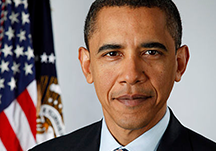William C. Potter and Benjamin Pack
April 10, 2014
View the Full Article
Policy Brief No. 10
Asia Pacific Leadership Network for Nuclear Non-Proliferation and Disarmament (APLN)
and Centre for Nuclear Non-Proliferation and Disarmament (CNND)
Advancing Nuclear Disarmament: The US Role
Summary

President Barack Obama
Wikimedia Commons
A year into President Obama’s second term, the outlook for US leadership in advancing nuclear disarmament is bleak, especially in contrast to the promise of the “Arms Control Spring” of 2010.
To be sure, the administration does not shoulder all of the blame for the slow pace in implementing the president’s Prague agenda. Russian opposition to further nuclear cuts and Congressional obstructionism to anything progressive have hamstrung key presidential priorities. But the administration has also failed to capitalize on opportunities to exercise US leadership when they have presented themselves – the decision not to attend the Second Conference on the Humanitarian Impact of Nuclear Weapons in Nayarit, Mexico in February 2014 being the most recent.
While the impediments to a more assertive US role in advancing nuclear disarmament are immense, progress could be achieved if the administration is willing to introduce adjustments to nuclear force posture and doctrine that are necessary because of pressing budgetary constraints. In addition, they can and should identify more ambitious initiatives for action within the P5 Process, while promoting disarmament and non-proliferation education and the expansion of nuclear-weapon-free zones.
Astute and bold leadership by the president will be required to revitalize the Prague agenda and to realize more fully its promise.
